SolarWinds Module
The SolarWinds NPM Module provides a bidirectional communication channel between SolarWinds NPM and Resolve Actions Express. The connection between Actions Express and SolarWinds is performed directly through the SolarWinds backend MS SQL Server database. After you add and configure the module, Actions Express pulls new alerts and alert updates, translates them into incidents, and displays them as incidents. Alerts recovered in the SolarWinds NPM console trigger incident closure in Actions Express.
Prerequisites
The following provisions must be made before configuring the module.
User Access
The user of the integration module must have db_owner permissions on the SolarWinds MS SQL Server database.
Server Clock Synchronization
The clock on the SolarWinds NPM server machine must be in sync with the clock on the machine where the module is running. Depending on the module mode (Cloud or Remote), this could be the main Actions Express machine or another machine.
Creating the Module Instance
You need to configure a module instance for each SolarWinds NPM server that you want to integrate with.
- Go to Main Menu > Configuration > Modules.
- From the top right corner of Integrations, click +.
The module properties screen appears. - In the Name field, enter a name for the new module instance.
It is a good practice to provide a descriptive name to let you distinguish between multiple module instances of the same type. - (optional) In the Description field, enter a description for the module instance.
- From the Type field, select SolarWinds NPM.
- In Mode, select where you want the module instance to run:
- Cloud—The module instance will run in your cloud instance of Actions Express. This option is suitable for integration with services that run in the cloud or on-premises services that are accessible from the cloud.
- Remote—The module instance will run on the server where you installed the remote executor (installing a remote executor is needed when the server does not have access to the SQL DB). This option is suitable for integration with services that run in a separate network and are normally not accessible from the main network where Actions Express runs.
- Check Monitor if you want Actions Express to monitor the module instance.
By selecting this option, a new incident is created when the instance is down. - (Mode: Remote only) When you have one or more SolarWinds NPM modules installed on remote machines, you can select to which remote SolarWinds NPM module you want to connect. Select the device where the module instance is installed from Module Instance > Device, as well as the Port through which it will communicate.
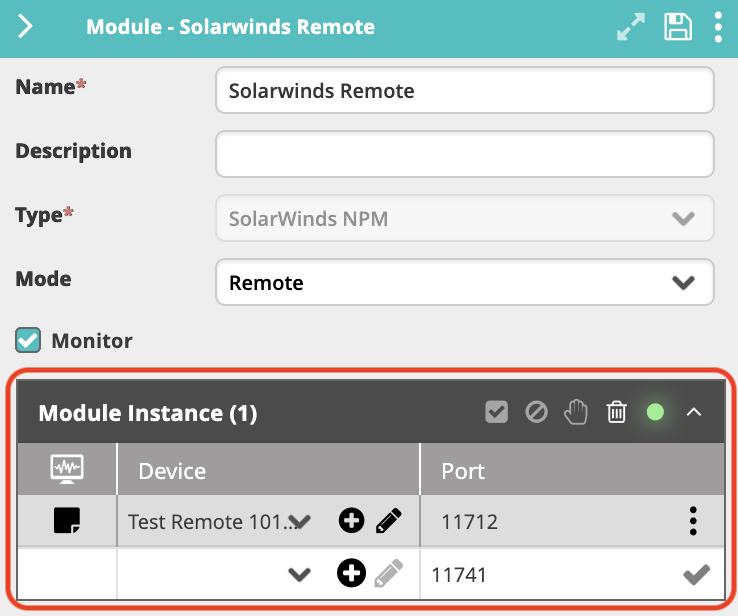
- If you haven't predefined a Device within Incident Configuration, you can click the plus icon to add a new Device directly from this screen. Enter a Name and an IP Address within the configuration, where the Name must be resolvable within DNS (FQDN) or IP Address.
- Click Save to create the module.
- In the Connection Parameters section, specify the SolarWinds NPM server connection details:
- In the Device field, select the device where the SolarWinds MS SQL database is installed from the drop-down.
- If you haven't predefined a Device within Incident Configuration, you can click the plus icon to add a new Device directly from this screen. Enter a Name and an IP Address within the configuration, where the Name must be resolvable within DNS (FQDN) or IP Address).
- In the Port field, enter the port through which the SolarWinds MS SQL database is accessed. The default is
1433. - In the User name and Password fields, enter the db_owner credentials.note
You can assign lower DB permissions depending on the rights that you want to specify for the user account (for example, reading, creating, or updating alerts).
- Click Test Connection to verify your connection with the server.
A valid connection is indicated with a green tick icon.
- In the Device field, select the device where the SolarWinds MS SQL database is installed from the drop-down.
- Click Save again to complete this section of the configuration.
- In the Configuration Options section, specify additional generic module instance options:
- Log Level—Select how verbose you want the module-related log messages to be. Level 1 is the least verbose.
The log file is located in the module's installation folder (
C:\Program Files\Resolve\Actions Express SolarWinds NPMby default).
- Log Level—Select how verbose you want the module-related log messages to be. Level 1 is the least verbose.
The log file is located in the module's installation folder (
- Click Save.
Selecting SolarWinds NPM Alerts
Once the SolarWinds NPM module has been fully configured, you can enable it to monitor for alerts, as well as define their filters and mapping options.
Click the expand icon () in the module configuration screen.
The Forms, Filters, and Mapping tabs appear, displaying the available SolarWinds NPM forms and properties. Each form corresponds to a SolarWinds NPM alert.
- In the Forms tab, a single row displaying the name Default is listed. To discover all fields associated with SolarWinds NPM alerts, click the discover icon that appears next to its name after selecting it (
).
Once discovery is complete, the icon will change to circular arrows to indicate this.
- Check the box in the Monitoring column (
) if you want Actions Express to monitor data in this project and create events for detected SolarWinds NPM updates.
- Checking Bypass Incident (
) will process Actions Express events (records and updates) without creating incidents. Depending on your specific needs, this can be useful when the incoming information is not critical, and you simply want to use it in workflows.
- Check Execute Workflow on Every Update (
) to run the corresponding workflow upon each update of the incident, or clear to run it only upon the first instance.
- In a high-volume environment, we recommend setting the Monitoring Interval value between 30 and 60, meaning that Actions Express will check for SolarWinds NPM updates every 30 to 60 seconds. By default, it is set to 10.
- Once you have configured the project form, click Save to update the module settings.
Applying Filters
Filters determine which alerts will be discovered by Actions Express. To get all requests for a specific alert, do not create any filters.
- While still in the Forms tab, click on the default to select it.
- Click the Filters tab.
- In the Name column, enter the name of the filter you want to create and hit Enter or click the check mark. This name should be indicative of the criteria defining the filter.
- In the Filter Columns table:
- In the Name column, select one of the discovered SolarWinds NPM alert fields on which to base the filtering.
- In Relation, select the type of relationship you want in the filter. The possible values here will vary based on the selected relation type.note
Numeric value fields such as
_Severitycan only have anEquals/Not equalsrelation.Contains/Not containsis not supported. - In Value, choose the values you want to capture.
Mapping SolarWinds NPM Properties
In the Mapping tab, you can translate SolarWinds NPM properties into Actions Express incidents. The window is divided into three sections: Fields, Severity, and State.
Fields
In this section, you can translate SolarWinds NPM properties into Actions Express variables. The SolarWinds NPM properties list (the drop-down in each row of the Integration column) is updated automatically based on the discovery completed in the Forms tab.
To remove a field, click the X icon next to its name. To add a new field, click the down arrow in the empty row.

Severity
In this section, you can translate SolarWinds NPM alert severity into Actions Express severity. There are two options for severity selection:
- Static Severity—All alerts open an Actions Express incident with the selected static severity.
- Customized Severity—Enables you to map the values of a specified field of the SolarWinds NPM alert against the Actions Express severity.
An Actions Express severity can be mapped into several SolarWinds NPM severity values. For example, if you want all SolarWinds NPM severity values of 1 and 2 to be opened as Critical incidents in Actions Express, check the 1 and 2 options in the Integration Severity field:
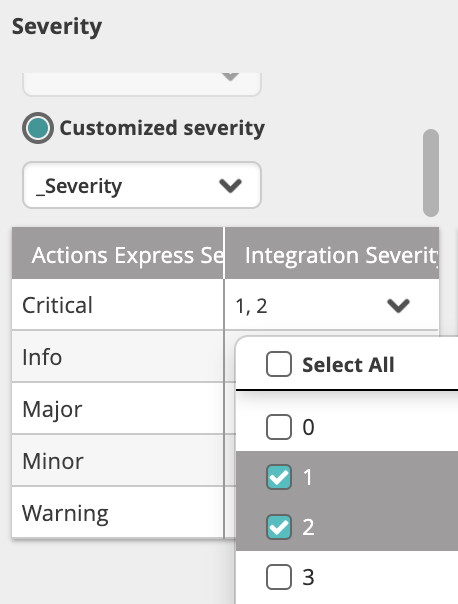
You can also type values manually instead of selecting them from the drop-down menu. The manually entered values must exist in the drop-down list and are case-sensitive.
State
In this section, you can translate SolarWinds NPM states into Actions Express states.
Currently, you can only assign a Static State with SolarWinds NPM alerts. This means that all alerts open an Actions Express incident with the selected static state.
When using a static state, closing/clearing an alert in SolarWinds NPM does not close the Actions Express incident, and vice versa.
When more than one mapping option is selected for the Up state, closing the incident in the Actions Express LIVE Dashboard changes the selected property to the first option in the list.
Using SolarWinds Variables
In the SolarWinds module, related variables are discovered in Actions Express and can be used to define conditions or to configure an activity.
The "State" and "Severity" variables in SolarWinds correspond to "_State" and "_Severity" in Actions Express.
In a Condition
To use SolarWinds variables in a condition:
- In the Main Menu > Repository > General > Conditions list, click the condition name and open its configuration panel on the right.
- In the Type column, select the name of the SolarWinds module from the list.
- In the Module Form column, select the relevant form name to discover its fields. You can add as many form entries as needed.
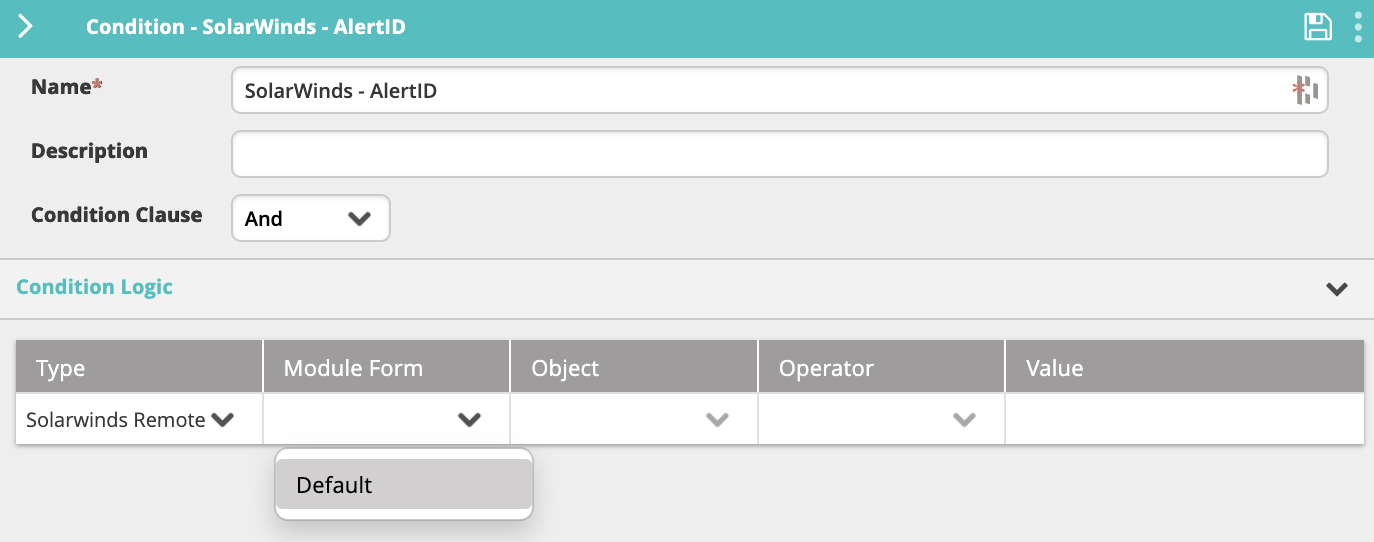 All imported SolarWinds variables will appear in the Object list.
All imported SolarWinds variables will appear in the Object list.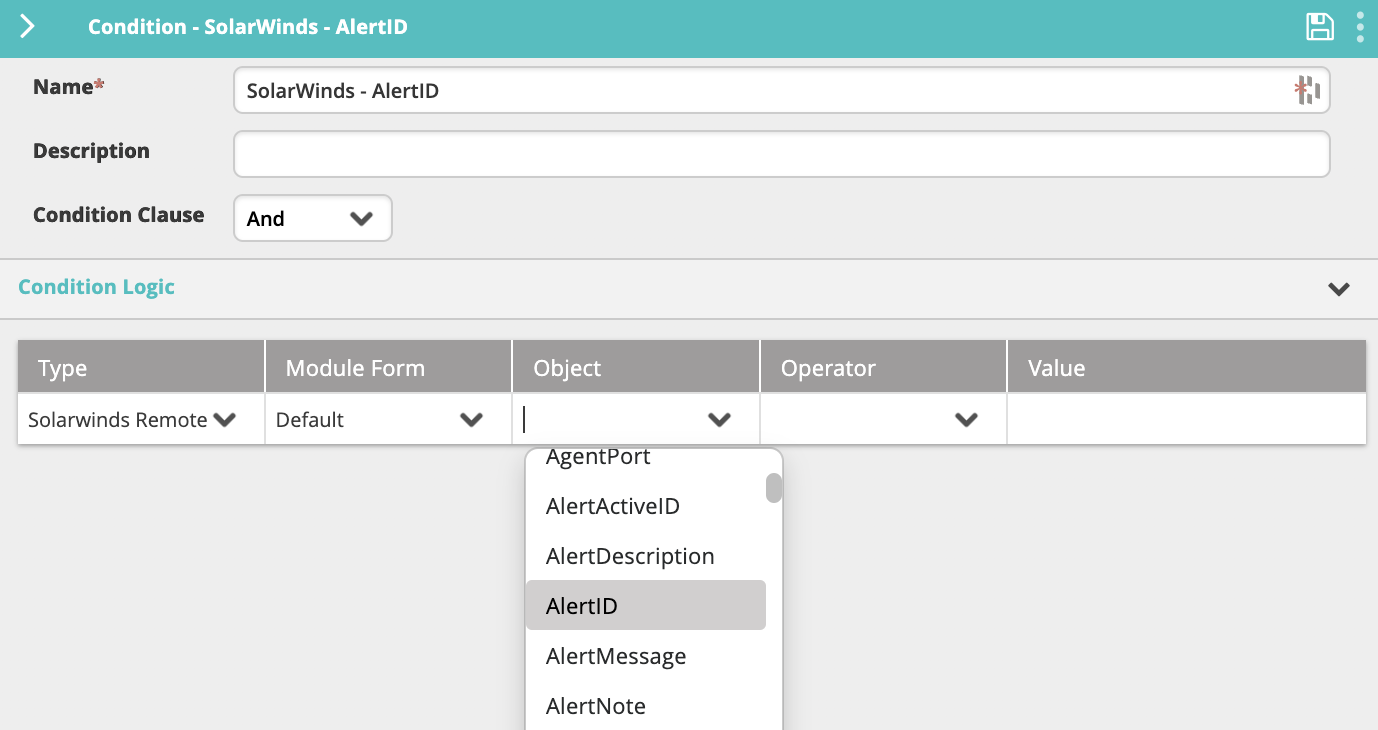
- If you add the form to the condition and the Condition Clause field is set to "And", only fields from the specified form will match the condition.
In an Activity
To use SolarWinds variables in an activity:
- In the Main Menu > Builder > Workflow Designer, open the activity settings.
- In the desired field, type
%. This will open the variable menu. - You can either continue to type the variable name if you know it, or click on the Modules tab, find the SolarWinds module and select the variable you want to use.
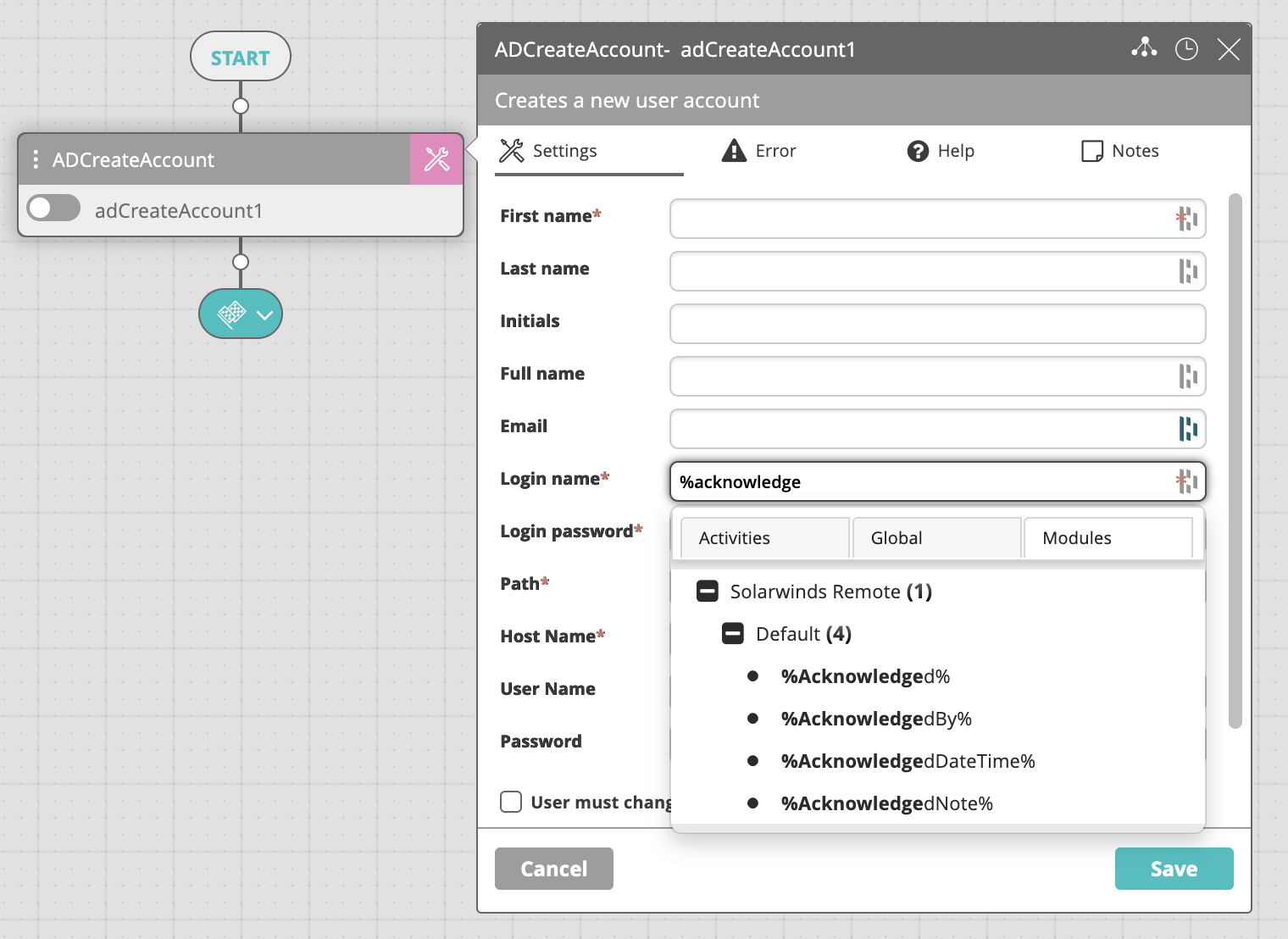
Troubleshooting
Use this information to resolve common issues that may occur with this integration module.
Error: "Failed Test Connection"
This error can appear when testing the connection during module configuration.
Probable Cause
- No connectivity to the database server;
- The device that was selected in the Connection Parameters section either doesn't have the SolarWinds NPM database installed or SolarWinds NPM services aren't running on it.
Possible Resolution
In the first case, check if the connection parameters were entered correctly.
In the second, make sure that the device selected in the Connection Parameters has the SolarWinds NPM database installed or that SolarWinds NPM services are running on it.
Error: “Cannot open database “SolarWindsOrion”
This error can appear when a login attempt fails.
Probable Cause
The error indicates lack of connectivity with the database server.
Possible Resolution
To resolve the issue, verify the following:
- The port specified in the module Connection Parameters is the configured TCP/IP port to connect to the SolarWinds NPM database (make sure that the port is open).
- The Connection Parameters contain the correct user name and password to connect to the SolarWinds NPM module.
Related Activities
To use the Actions Express SolarWinds NPM activities, open the Workflow Designer in the Main Menu Builder section. Search, browse, or click the + in the canvas area to find the desired activity and add it to the workflow.
The following SolarWinds NPM activities are available: